
Our boys enjoy scratching things. To satisfy their natural need for scratching, the cats may use furniture, rugs, and other objects around the house. Marley loves to tear the carpet. Sunny likes to scratch our bed at night. And Joey’s favorite things to scratch are the walls, the desk, and our couch in the loft. My favorite desk (and Joey’s) has multiple scratch marks everywhere.
Cat furniture scratching is an issue that may discourage people from adopting cats or having them indoors.
Understanding your cat’s behavior, correct re-direction, and providing the right supplies may help successfully manage your cat indoors and prevent destructive scratching.
Observe your cat.
The first thing to do will be to observe your cat and find out where are his favorite places to scratch. Cats prefer different types of surfaces and a variety of textures. We noticed that each cat in the household has his favorite objects and spots for scratching. Sometimes cats like hard materials. For example, Joey likes the walls and the desk in the office. Another favorite object is my old anatomy book. Joey shredded the book cover in pieces, and we decided to leave it accessible for Joey. Sunny loves to crawl inside of the bed and scratch the mattresses. Marley enjoys tearing up the carpet in the bedroom and doesn’t care about the walls or the desk.
Provide multiple scratching posts and scratchers.
After identifying your cat’s favorite scratching places, provide scratching posts and scratchers. Position them in the same spots where the cats like to scratch. We put a cat tree against the wall and placed a cardboard scratching board next to the desk drawer with Joey’s scratch marks. For Sunny and Marley, we have a few cardboard scratchers on the floor in the bedroom. There is another cat tree in the living room with three scratching posts.
Allow your cat to discover new scratch posts.
Your cats need time to get used to the new items in the house. Make the experience natural and enjoyable for them. Encourage the use of the cat trees or scratching posts, play with the cats using the items. Be very patient with your furry companions. Never force your cat to use the scratchers. Such behaviors will intimidate your cat and discourage him from using the new scratching devices.
Try different materials.
The cats like to scratch different textures and materials. In our family, every cat has his favorite objects. Sunny prefers soft bedding materials. Marley enjoys scratching the carpets. When he tears the bedroom floor, his face lights up. Joey is the only cat in the family who loves hard surfaces, such as the desk and the walls. We saw him sitting and scratching the wall multiple times.
You can use the commercial cardboard scratchers or make them yourself from the cardboard boxes. Your cat may enjoy a cat tree with a built-in scratcher, or you may purchase the scratching post individually.
Praise your cat for using a scratching post.
You want to make the experience pleasant for your cat. Praise your friend whenever he scratches the cat tree or a post. When your cat scratches furniture, avoid yelling and screaming at him. Cats don’t understand why you yell at them. Screaming is threatening for the animals and will affect your cat’s trust. Instead, gently re-direct the kitty and offer to use a toy, scratching post, or a cat tree.
Cover your furniture.
Cats scratch furniture because they like the texture of the material. We covered our couch with a bulky throw. Such a measure helped protect the fabric and decreased the incidences of scratching. Soon, the cats lost interest in tearing up the piece. Covers may not be appropriate all the time, and they may not look great. At the same time, your cats may not like the new texture for scratching and will lose interest in your object. Additionally, the cover physically protects furniture from sneaky nails.
Conclusion.
Remember that patience is the most important thing when working with your cats. Scratching is a natural behavior, and the cats don’t want to annoy you. Initially, watch your cats and determine their favorite spots and objects for scratching. Provide a variety of scratchers, including cardboard and scratch posts. Try different materials, textures, and shapes of the scratchers. Gently rechannel your companion’s attention and praise the desired behavior. Remember, no yelling and screaming at your cats. Be patient, consistent, and use critical thinking.
